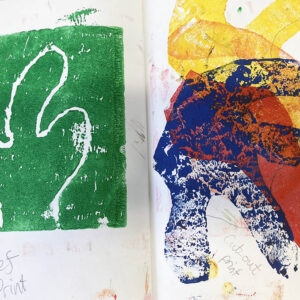Pathway: Working with Shape and Colour
Pathway for Years 3 & 4
Disciplines:
Printmaking (Stencil/Screen Print), Collage
Key Concepts:
-
That we can be inspired by key artworks and make our own work in creative response.
-
That we can use shape and colour as a way to simplify elements of the world.
-
That shapes have both a positive and negative element.
-
That we can arrange shapes to create exciting compositions.
-
That we can build up imagery through layering shapes.
-
That we can use collage to inspire prints.
In this pathway children use close looking and the “Show Me What You See” technique to explore artwork from a particular artist, movement or era. Children then explore how they can use shape and colour to simplify elements, inspired by the Cut-outs of Henri Matisse.
Using first collage, then simple printmaking methods, pupils play with positive and negative shapes and spaces to create meaningful compositions in response to the original artworks they looked at.
Medium:
Paper, Printmaking Ink, Stencils & Crayons
Artist: Henri Matisse, Claire Willberg
If you use this resource in your setting, please tag us on social media: #InspiredBy @accessart (facebook, twitter) @accessart.org.uk (instagram) and share the url. Thank you!




Teaching Notes
Find the MTP for this pathway here.
Find the Zoom CPD session introducing this pathway here.
See the recording of the Zoom CPD session exploring Screen Printing in the classroom.
Curriculum Links
History: Choose a painting as inspiration which typifies a particular historical period, for example, a painting from Ancient Egyptian.
Maths: 2D/3D shapes, pattern.
PSHE: Peer discussion.
I Can…
-
I can explore an artwork through looking, talking and drawing.
-
I can use the “Show Me What You See” technique to help me look closely, working in my sketchbook making drawings and notes using pencils and pens.
-
I can cut shapes directly into paper, using scissors, inspired by the artwork.
-
I can collage with my cut elements, choosing colour, shape and composition to make my own creative response to the artwork.
-
I can add to my collage, using line, colour and shape made by stencils.
-
I can explore negative and positive shapes.
-
I can take photographs of my work.
-
I can share my work with my class. I can reflect and share what I like, and what I would like to try again. I can look at the work of my classmates and give useful feedback through class or small group discussion.
Time
This pathway takes 6 weeks, with an hour per week. Follow the stages in green for a shorter pathway or less complex journey.
Materials
Soft B pencils, coloured pencils, oil/chalk pastels, A3 or A2 sugar or cartridge paper, collage papers, PVA glue, scissors.
Option 1: Monoprinting with Carbon Paper – Carbon paper, sharp pencil or pen, oil pastels.
Option 2: Explore Stencils – Card, oil pastels, scissors.
Option 3: Screenprinting mesh, water-based printing ink, tray, acrylic printing medium, scrap card for squeegee, embroidery hoop (optional), newsprint.
See the Pathway Used in Schools...































